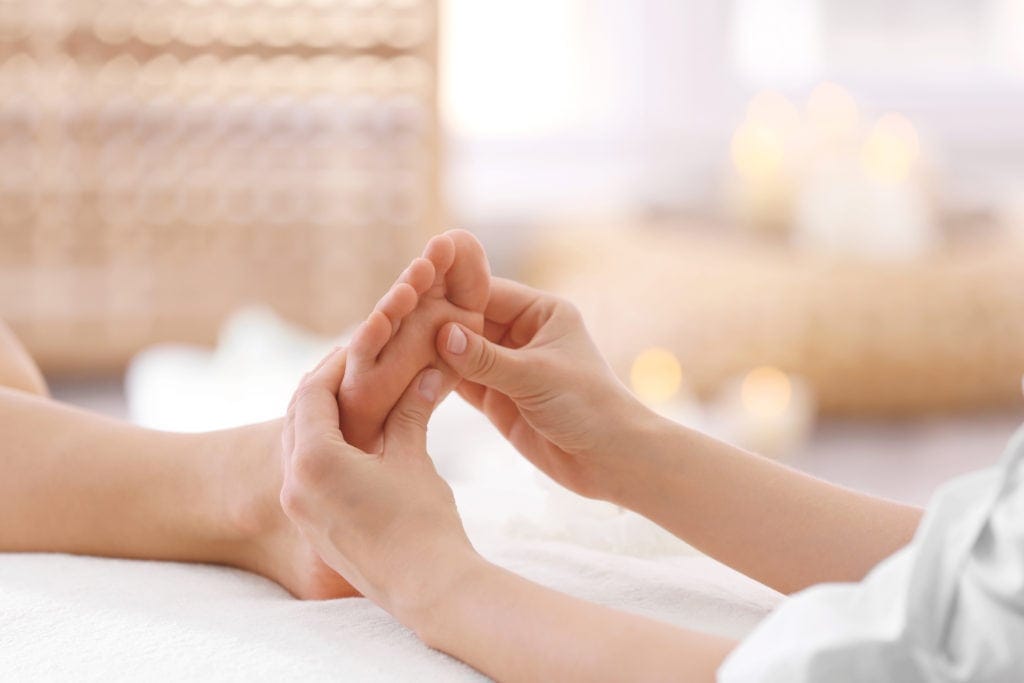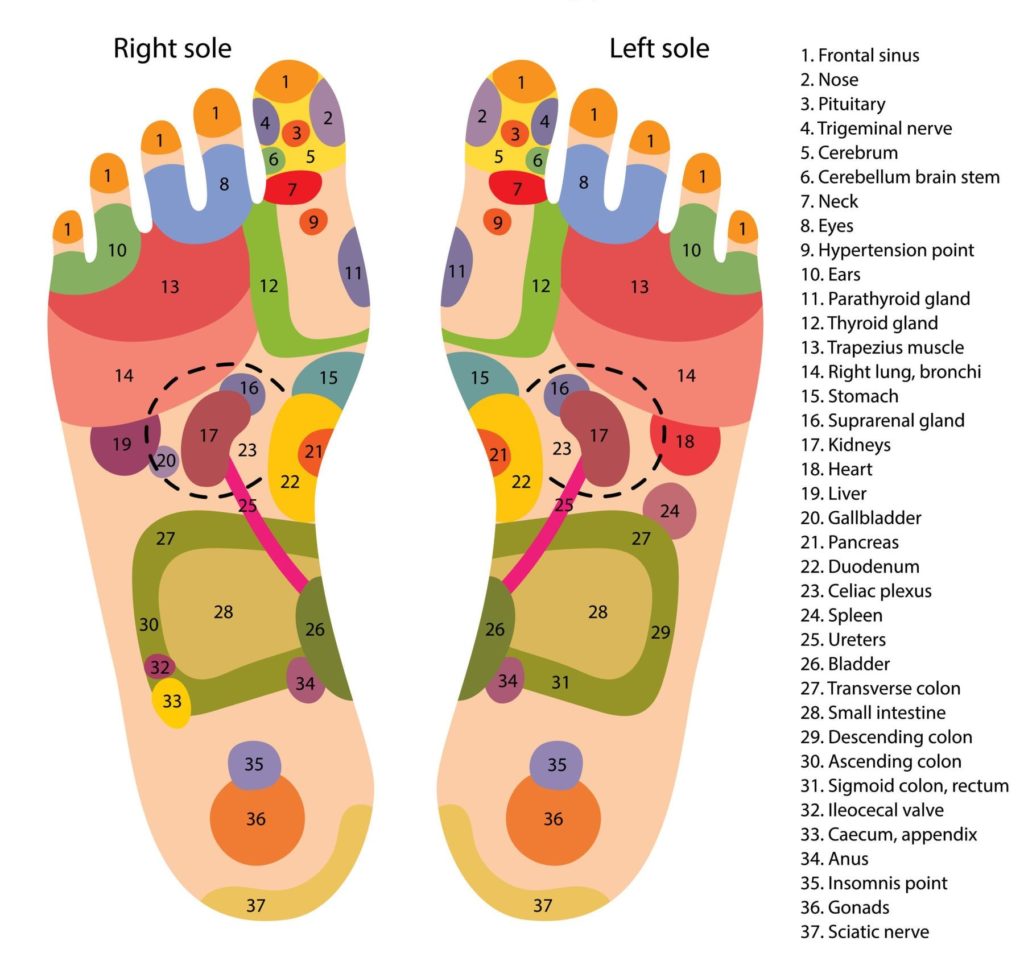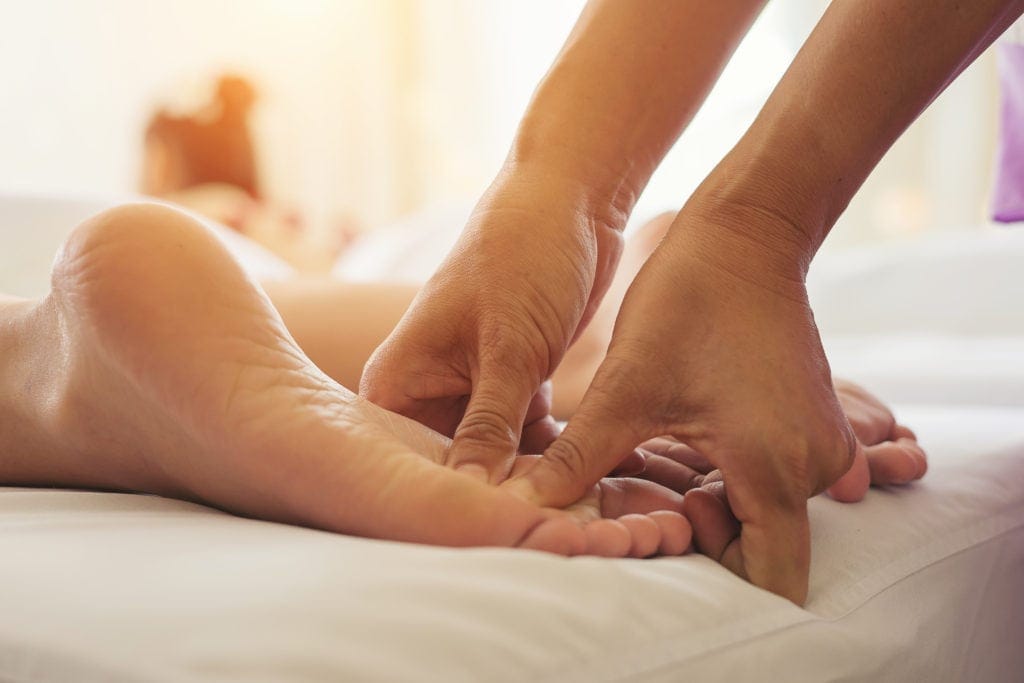Reflexology is based on the theory that our organs are reflected in other parts of our body, for example, the hands and feet. Based on William Fitzgerald’s ‘zone theory’, which divided the body into ten vertical zones, the first roadmap of reflexology was produced in the 1920s. This ‘roadmap’ gave reflexologists a map of the body’s internal organs and systems on the feet, hands and ears. In reflexology, the left foot is thought to stimulate the left side of the body and the right foot the right side.

By applying pressure to your hands, feet and ears, a reflexologist sends calming messages from the peripheral nerves to the central nervous system. This can signal to the body to adjust its tension levels and reduce feelings of pain.
While reflexology shouldn’t be used in place of traditional medical treatment, research has found that reflexology can help with reducing stress, back pain and migraines, as well as helping you sleep better at night.
How does reflexology work?
There are a number of different theories as to why reflexology works for patients. Here, we’ll take a look at these different ideas:
Reflexology helps the central nervous system: Research conducted by Sir Henry Head and Sir Charles Sherrington in the 1890s found a neurological connection between the skin and the internal organs. According to the theory, by touching and massaging a certain part of the foot, calming messages are sent along the nerves to the relevant part of the body that’s causing you pain.
Reflexology reduces pain by reducing stress: The neuromatrix theory of pain, put forward by the psychologist Ronald Melzack in 1990, sees pain as an experience created in the brain. This theory is often used to explain chronic pain in patients; for example, a patient who has severe lower back pain but an MRI scan shows they have no tears in the ligaments or damage to the spine’s disks. Melzack’s theory argues that the pain lies in the brain, not at the point where the patient feels it in their back. According to this theory, outside factors that influence the brain, such as a person’s mood or stress levels, can also affect their experience of pain. Therefore, reflexology can help with pain by reducing stress and improving a patient’s mood.
Foot Reflexology Chart

Reflexology helps release blockages in the body: Another theory believed by reflexology therapists is based on ‘qi’ in traditional Chinese medicine. Qi is the ‘vital energy’ that flows through the body. When a person feels stressed, this energy is ‘blocked’. Through manipulation, a reflexologist can keep the energy flowing in the body, emitting endorphins associated with stress and pain reduction to be used where they are needed in the body. This theory, however, has been rejected by the medical community, as there is no evidence of ‘vital energy’.
What is the difference between reflexology and massage?
While they might sound similar on paper, reflexology and massage are very different. Massage involves the manipulation of soft body tissue to relax the muscles. A massive therapist will use a number of different techniques, such as kneading and stroking the muscles to release tension.
Reflexology will focus on the hands, feet and ears and use the mapping system mentioned above. The reflexologist will use small micromovements to apply pressure to different areas, using the thumb and fingers. The idea with reflexology is to create a response throughout the body, not at the site of manipulation.

How can reflexology help me?
While the medical community does not recommend reflexology as a treatment for any specific illness, it is withheld as an alternative therapy for a number of different conditions.
Stress and anxiety: Although stress and anxiety is often a part of day to day life, too much stress can be bad for the body. In fact, stress has been linked with high blood pressure, fatigue, depression and heart disease. Reflexology is based on the principle of human touch, which is often considered to be an anxiety-reducing action, helping an individual lower and manage stress. In a small study into the benefits of reflexology, researchers looked at the effects one 30-minute reflexology treatment had on people being treated for breast or lung cancer. The study found those who received the reflexology treatment had lower levels of anxiety compared to those who didn’t. [Link to study: https://pubmed.ncbi.nlm.nih.gov/10660924/]
Reducing back pain: Back pain is a very common complaint, with eight out of ten people experiencing it in their lifetime. As well as environmental factors, such as being sat down behind a computer screen all day, back pain can also be exaggerated when the body is stressed or anxious. On a reflexology map, the spine is located along the inside edge of each foot, from the base of the big toe to the heel. A reflexologist will manipulate this area to help release tension in the back. In fact, in a study conducted on doctors and nurses, who often struggle with back pain, reflexology was found to be an effective method of reducing the severity of chronic back pain. [Link to study: https://www.ncbi.nlm.nih.gov/pmc/articles/PMC3696219/]
Helping patients sleep better: According to the reflexology roadmap, there is a specific point on the base of the foot, which is referred to as the insomnia point. Usually, if patients are struggling to sleep, a reflexologist will focus on this area, helping to induce feelings of calm and helping the patient to sleep better.
Fertility and conception: When couples are struggling to conceive, they will often feel stressed and anxious, which can be counterproductive. Reflexology can help reduce stress and put the body into a more relaxed state, which can be useful for both you and your partner when trying for a baby.
How should I find a reflexologist near me?
If you think reflexology sounds right for you and want to speak to a reflexologist to find out more, use Reflexology Pages to find a therapist near you. Just enter your postcode to receive a directory of local therapists, with most areas of the UK covered.
